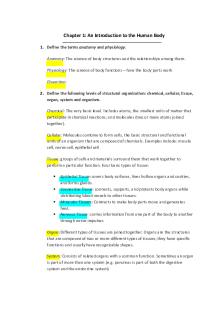Chapter 1: study Guide PDF

| Title | Chapter 1: study Guide |
|---|---|
| Author | Elsa Assefa |
| Course | Human Anatomy and Physiology |
| Institution | Athabasca University |
| Pages | 4 |
| File Size | 100.5 KB |
| File Type | |
| Total Downloads | 99 |
| Total Views | 147 |
Summary
Chapter 1: study guide, Chapter 1: study guide...
Description
Chapter 1 An Introduction to the Human Body Objectives After completing this chapter, you should be able to 1. 2.
define the terms anatomy and physiology. define the following levels of structural organization: chemical, cellular, tissue, organ, system and organism. 3. identify the 11 systems of the human body, list representative organs of each system, and describe the major functions of each system. 4. identify the basic life processes of the human body. 5. define the term homeostasis, and explain the effects of stress on homeostasis. 6. describe the components of a feedback system. 7. compare the operation of negative and positive feedback systems. 8. explain the relationship between homeostasis and disease. 9. describe the anatomical position, and compare common and anatomical terms used to describe various regions of the human body. 10. define the terms describing directions and anatomical planes used in association with the human body. 11. list, by name and location, the principal body cavities and the organs contained within them.
Keywords and Topics Make certain that you can define, and use in context, each of the terms listed below, and that you understand the significance of each of the concepts. 1.
Define the terms anatomy and physiology. A. anatomy B. dissection C. physiology 2. Define the following levels of structural organization: chemical, cellular, tissue, organ, system, and organism. A. chemical level
I. atom II. molecule B. cellular level I. cell C. tissue level I. tissue D. organ level I. organ E. system level I. system F. organismal level I. organism 3. Identify the 11 systems of the human body, list representative organs of each system, and describe the major functions of each system. A. systems: integumentary; skeletal; muscular; nervous; endocrine; cardiovascular; lymphatic; respiratory; digestive; urinary; reproductive Note: Learn the major components and functions for each system.
4.
Define the basic life processes of the human body. A. metabolism I. catabolism II. anabolism B. responsiveness C. movement D. growth E. differentiation I. stem cells F. reproduction G. autopsy I. necropsy 5. Define the term homeostasis, and explain the effects of stress on homeostasis. A. homeostasis B. body fluids I. intracellular fluid (ICF) II. extracellular fluid (ECF) a. interstitial fluid = internal environment b. blood plasma c. lymph
6.
7.
8.
9.
d. cerebrospinal fluid e. synovial fluid f. aqueous humor g. vitreous body Describe the components of a feedback system. A. control of homeostasis; nerve impulses and hormones B. feedback system (feedback loop); controlled condition; stimulus C. receptor; afferent pathway; input D. control center; output; efferent pathway E. effector; response Compare the operation of negative and positive feedback systems. A. negative feedback systems; baroreceptors B. positive feedback systems Explain the relationship between homeostasis and disease. A. disorder B. disease C. symptoms D. signs E. diagnosis Describe the anatomical position, and compare common and anatomical terms used to describe various regions, of the human body. A. anatomical position I. prone position II. supine position B. regional names Note: Learn the common names for the major parts of the human body.
10.
Define the terms describing directions and anatomical planes used in association with the human body. A. directional terms Note: Learn all directional terms and their definitions from Exhibit 1.A.
B. C.
planes sagittal plane I. midsagittal plane (median plane); midline II. parasagittal plane D. frontal or coronal plane E. transverse plane (cross-sectional, horizontal)
F. oblique plane G. section (midsagittal, frontal, transverse) 11. List, by name and location, the principal body cavities and the organs contained within them. A. body cavities B. cranial cavity C. vertebral (spinal) canal I. meninges D. thoracic cavity I. pericardial cavity II. pleural cavity III. mediastinum IV. diaphragm E. abdominopelvic cavity I. abdominal cavity II. pelvic cavity III. viscera...
Similar Free PDFs

Chapter 1: Study Guide
- 3 Pages

Chapter 1 Study Guide
- 1 Pages

Chapter 1 - study guide
- 15 Pages

Chapter 1: study Guide
- 4 Pages

Chapter 1 Study Guide
- 11 Pages

Chapter 1 Study Guide
- 7 Pages

Chapter 1 Study Guide
- 4 Pages

Acct Chapter 1 Study Guide
- 8 Pages

Chapter 1 Study Guide MKT
- 22 Pages

Chapter 1 Study Guide Answers
- 12 Pages

Chapter 1 Study Guide Answers
- 4 Pages

Chapter 1-2 study guide
- 4 Pages

Study Guide Chapter 1 Vocabulary
- 5 Pages

Chemistry Chapter 1 Study Guide
- 4 Pages

Chapter 1 study guide vocabulary
- 1 Pages

Antomy Study Guide Chapter 1
- 2 Pages
Popular Institutions
- Tinajero National High School - Annex
- Politeknik Caltex Riau
- Yokohama City University
- SGT University
- University of Al-Qadisiyah
- Divine Word College of Vigan
- Techniek College Rotterdam
- Universidade de Santiago
- Universiti Teknologi MARA Cawangan Johor Kampus Pasir Gudang
- Poltekkes Kemenkes Yogyakarta
- Baguio City National High School
- Colegio san marcos
- preparatoria uno
- Centro de Bachillerato Tecnológico Industrial y de Servicios No. 107
- Dalian Maritime University
- Quang Trung Secondary School
- Colegio Tecnológico en Informática
- Corporación Regional de Educación Superior
- Grupo CEDVA
- Dar Al Uloom University
- Centro de Estudios Preuniversitarios de la Universidad Nacional de Ingeniería
- 上智大学
- Aakash International School, Nuna Majara
- San Felipe Neri Catholic School
- Kang Chiao International School - New Taipei City
- Misamis Occidental National High School
- Institución Educativa Escuela Normal Juan Ladrilleros
- Kolehiyo ng Pantukan
- Batanes State College
- Instituto Continental
- Sekolah Menengah Kejuruan Kesehatan Kaltara (Tarakan)
- Colegio de La Inmaculada Concepcion - Cebu